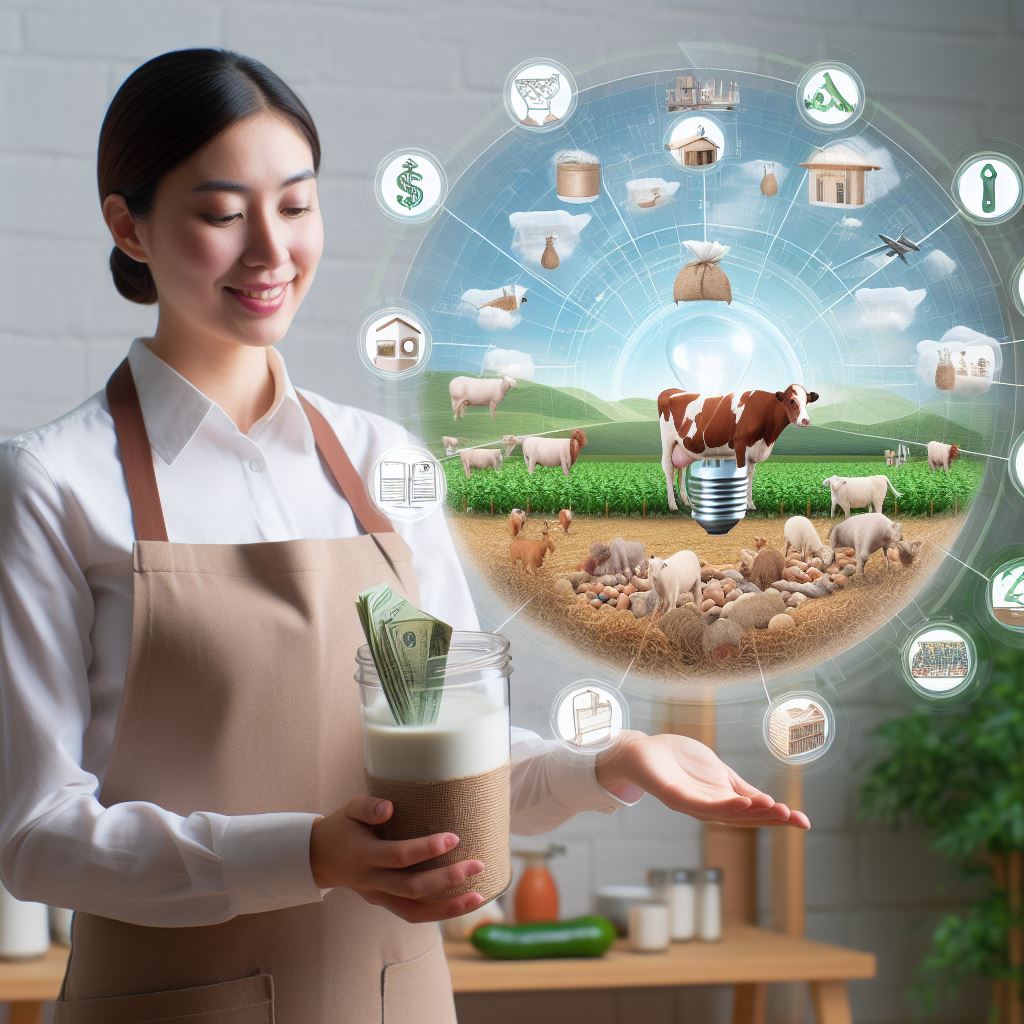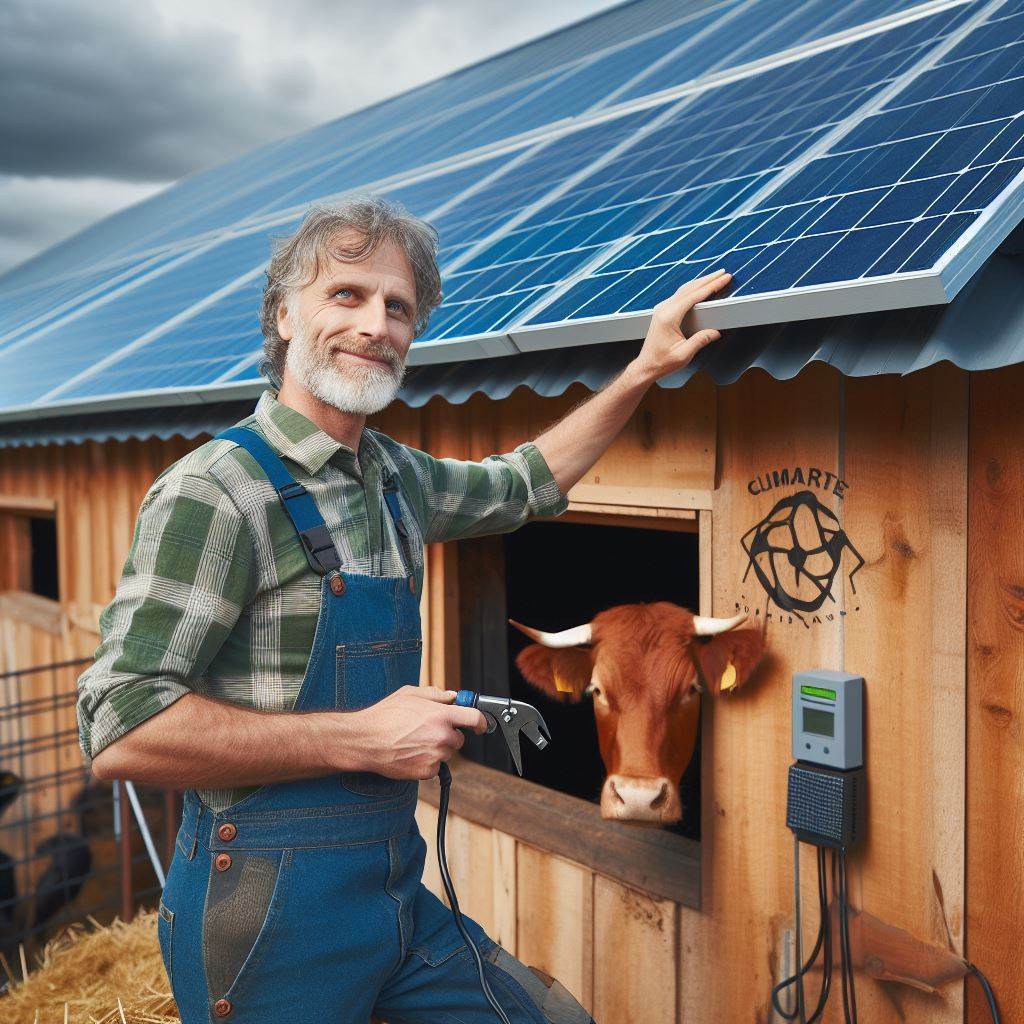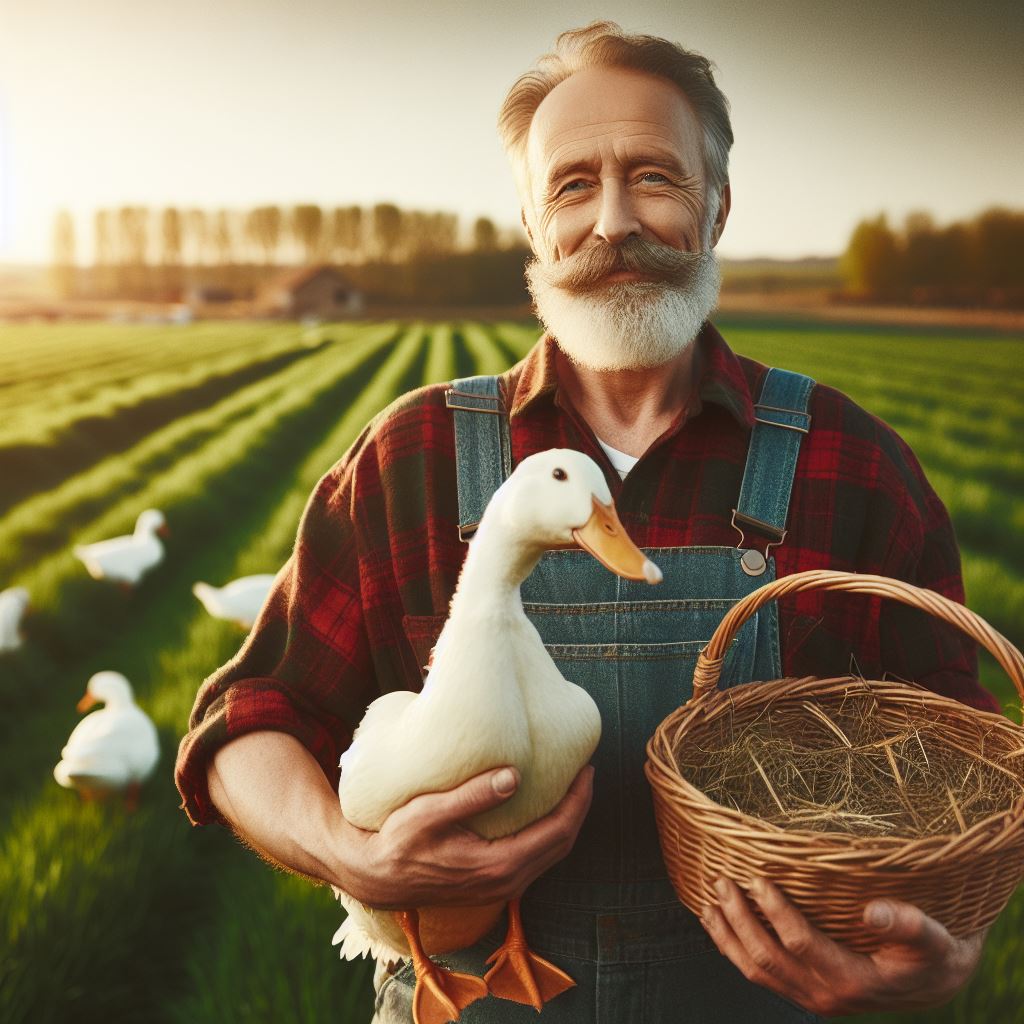Introduction
Brief explanation of sustainable livestock feed
Sustainable livestock feed refers to feed options that are environmentally friendly and economically viable.
Importance of sustainable livestock feed for animal health and the environment
Sustainable livestock feed is crucial for ensuring animal health, reducing environmental impact, and promoting overall sustainability.
Livestock animals require a balanced and nutritious diet to thrive and produce high-quality products.
However, conventional feed production methods often rely on non-renewable resources, chemical fertilizers, and excessive water usage, leading to environmental degradation.
Moreover, the production and transportation of feed ingredients contribute to greenhouse gas emissions and land degradation.
Sustainable livestock feed solutions minimize these negative impacts by employing eco-friendly farming practices, utilizing locally available resources, and reducing waste.
For instance, incorporating alternative protein sources, such as insects, algae, or single-cell proteins, into animal diets reduces the reliance on unsustainable feed ingredients like soy or fishmeal.
Similarly, implementing precision feeding techniques and improving digestibility through enzymatic additives can enhance feed utilization efficiency, reducing the overall amount of feed required.
Furthermore, sustainable livestock feed promotes the use of regenerative agricultural practices, such as rotational grazing, cover cropping, and agroforestry, to preserve soil health, enhance biodiversity, and sequester carbon.
By adopting sustainable livestock feed ideas, farmers can not only enhance animal welfare and performance but also contribute to a healthier environment and resilient food systems.
Additionally, sustainable feed practices can reduce production costs and enhance market opportunities, as consumers increasingly demand sustainable and ethically sourced products.
Therefore, it is crucial to explore and implement innovative feed alternatives to ensure a sustainable future for both livestock production and the planet.
Traditional Livestock Feed Options
Description of Common Conventional Feed Options
- Corn: Farmers commonly use corn as a primary feed option due to its high energy content.
- Soybean Meal: It is a popular protein source for livestock feed due to its high nutritional value.
- Alfalfa Hay: This feed option is rich in vitamins, minerals, and fiber, promoting good digestion in animals.
- Barley: Barley is rich in carbohydrates, making it an ideal feed option for livestock.
- Wheat: Wheat is a common feed option for livestock as it provides both energy and protein.
Drawbacks of Traditional Feed Options
Traditional feed production has widespread environmental and health drawbacks, necessitating a shift toward sustainable alternatives.
The impact includes:
- Environmental Degradation: Conventional feed production often leads to deforestation and water pollution.
- Resource Depletion: Traditional options require vast land, water, and energy, depleting natural resources.
- Soil Erosion: Unsustainable practices contribute to soil erosion, reducing fertility.
- Chemical Use: Reliance on fertilizers and pesticides harms ecosystems and animal health.
- Greenhouse Gas Emissions: Livestock on traditional feed contribute to climate change through emissions.
- Water Consumption: Substantial water usage strains limited resources for conventional feed options.
- Waste Disposal: Proper disposal from conventional feed poses pollution challenges.
- Nutritional Deficiency: Traditional feed may lack essential nutrients, impacting animal health.
- CAFOs: Traditional feed supports intensive farming, raising animal welfare concerns.
- Agricultural Dependence: Sole reliance on conventional feed creates vulnerability to market fluctuations.
- Monoculture: Growing demand contributes to monoculture expansion, reducing biodiversity.
- Antibiotic Resistance: Antibiotic use leads to the development of antibiotic-resistant bacteria.
- High Costs: Traditional feed can be costly, affecting farmer profitability and viability.
- Unsustainable Conversion: Inefficiency as significant amounts of feed produce a small amount of meat.
- Lack of Innovation: Hindrance to exploring alternative, more sustainable feed sources.
- Negative Public Perception: Environmental and health concerns lead to public backlash.
Most importantly, a shift to sustainable alternatives is imperative for a more eco-friendly and viable future in livestock production.
Transform Your Agribusiness
Unlock your farm's potential with expert advice tailored to your needs. Get actionable steps that drive real results.
Get StartedRead: Eco-Friendly Livestock Shelters
Sustainable Alternative Feed Ideas
Overview of Sustainable Livestock Feed Alternatives
Choosing sustainable alternative feed ideas for livestock production is crucial for the long-term health and sustainability of our planet.
With the increasing demand for animal products and the associated environmental concerns, finding innovative and eco-friendly feed options is a necessity.
One of the emerging alternative feed ideas is the use of insects.
Insects are a rich source of protein and can be grown using organic waste products, making them a sustainable option.
As a bonus, insects have a low carbon footprint and require less water and land compared to traditional feed sources.
Microalgae is another promising alternative.
These tiny organisms are packed with nutrients and can be cultivated using simple and efficient methods.
By using microalgae as feed, farmers can reduce their reliance on conventional resources while providing a well-balanced diet for their livestock.
Looking beyond insects and microalgae, utilizing by-products from other industries is another sustainable option.
Brewery waste, for example, can be processed and turned into a nutritious feed source for animals.
This not only helps reduce waste but also saves resources that would have been used to produce conventional feed.
Natural grass and forage are also important feed alternatives.
Grazing animals on open pastures and letting them feed on natural grasses reduces the need for energy-intensive feed production.
This approach minimizes the environmental impact of livestock farming and promotes sustainable land use.
Repurposing food waste is another way to provide sustainable feed.
Instead of sending food waste to landfills, it can be processed and used as a nutritional source for livestock.
Not only does this reduce waste, but it also ensures that valuable nutrients are utilized efficiently.
Benefits of using sustainable feed options
Using sustainable feed options has numerous benefits.
Firstly, it helps reduce the carbon footprint of livestock production by minimizing the demand for resource-intensive feed production.
By conserving water, land, and energy, sustainable feed alternatives contribute to the overall sustainability of the agricultural industry.
Moreover, sustainable feeds often have a better nutritional profile, leading to improved animal health and welfare.
Healthy animals are more resistant to diseases, require less medication, and produce higher-quality products.
This presents economic advantages for farmers, as they can save on veterinary costs and achieve better market prices.
Showcase Your Farming Business
Publish your professional farming services profile on our blog for a one-time fee of $200 and reach a dedicated audience of farmers and agribusiness owners.
Publish Your ProfileAdditionally, using sustainable feed options can have positive economic impacts.
By reducing feed costs and improving productivity, farmers can increase their profitability.
This allows for a more sustainable and financially stable livestock farming industry.
In essence, exploring and implementing sustainable alternative feed ideas is essential for the future of livestock farming.
It not only addresses environmental concerns but also enhances animal welfare and economic viability.
By embracing innovative feed options, we can build a more sustainable and resilient agricultural industry.
Read: Top Feeding Tips for Healthy Sheep

Plant-Based Feed Alternatives
Discussion of various plant-based feed options (e.g., legumes, grasses, corn, soybeans)
Plant-based feed alternatives are gaining attention in sustainable livestock farming due to their numerous benefits. Let’s explore some popular options:
- Legumes: Leguminous plants like clover and alfalfa are rich in protein and can be used as forage. They improve soil fertility by fixing nitrogen.
- Grasses: Grazing animals such as cattle can rely on grasses like ryegrass and fescue. These provide essential nutrients and promote healthy rumen function.
- Corn: Corn is a versatile crop that can be processed into feed forms like silage or grain. It is high in energy, making it suitable for fattening livestock.
- Soybeans: Soybean meal is a common protein source in animal diets, especially for poultry and pigs. It is an excellent alternative to animal-based protein feeds.
Nutritional benefits of plant-based feed for livestock
Feeding livestock with plant-based options offers several nutritional advantages, benefiting both animals and the environment:
- Balanced Nutrition: Plant-based feeds can provide a well-rounded diet, containing essential carbohydrates, proteins, fats, vitamins, and minerals.
- Digestibility: Many plant-based feeds are easily digestible, allowing animals to absorb nutrients efficiently, leading to improved growth and production.
- Health Benefits: Balanced plant-based diets reduce the risk of certain health issues, such as obesity and cardiovascular diseases, in livestock.
- Reduced Antibiotic Use: Properly formulated plant-based feeds can lower the dependence on antibiotics, promoting healthier animals and reducing the risk of antibiotic resistance.
- Environmental Sustainability: Plant-based feeds have a lower carbon footprint compared to conventional feed options, contributing to reduced greenhouse gas emissions.
Examples of successful implementation of plant-based feed in livestock farming
Several livestock farms have already embraced plant-based feed alternatives and witnessed positive outcomes:
- The Happy Cow Ranch in California switched to a diet of primarily legumes and grasses for their cattle. This change resulted in healthier animals and improved pasture quality.
- Tofurkey, a leading tofu and plant-based protein manufacturer, implemented a soy-based feed for their turkeys. The turkeys exhibited enhanced vitality and improved meat quality.
- Organic Dairy Farms in Vermont incorporated a corn-based silage diet for their cows. This change led to increased milk production and reduced digestive issues in the animals.
- The Beyond Eggs project in South Africa utilized a soybean-based feed for their laying hens. The hens produced eggs with higher nutritional value and improved taste.
In fact, plant-based feed alternatives offer a sustainable and nutritionally beneficial option for livestock farming.
Legumes, grasses, corn, and soybeans have shown promising results in promoting animal health and reducing environmental impact.
Implementing these alternatives can pave the way for a more sustainable future in the livestock industry.
Read: Goat Nutrition: What Your Herd Needs
Insect-Based Feed Options
Introduction to using insects as livestock feed (e.g., mealworms, black soldier fly larvae)
Insects are gaining popularity as a sustainable alternative for livestock feed due to their numerous benefits.
Using insects such as mealworms and black soldier fly larvae as a source of feed has gained attention in recent years.
These insects are highly nutritious and can provide a balanced diet for various livestock species.
Their high protein content makes them an excellent alternative to traditional feed sources.
In addition to their nutritional value, using insects as feed can also help decrease land and water use.
The production of insect-based feed requires significantly less land and water compared to conventional feed sources.
This makes it a more sustainable option, especially in regions facing water scarcity and limited land availability.
Advantages of insect-based feed (e.g., high protein content, decreased land and water use)
One of the primary advantages of using insect-based feed is its high protein content.
Mealworms and black soldier fly larvae are rich in protein, making them an excellent source of amino acids for livestock.
Protein is essential for animal growth, reproduction, and overall health.
By incorporating insect-based feed, farmers can ensure their livestock receive adequate protein intake.
Furthermore, using insects as feed helps address the environmental concerns associated with traditional livestock feed production.
Rearing insects requires significantly less land compared to traditional crops used in feed production.
This can help preserve natural habitats and reduce deforestation caused by land clearing for agricultural purposes.
Moreover, insect rearing requires minimal water, especially compared to the water-demanding production of cereals or legumes.
Conserving water resources is crucial for sustainable farming in areas prone to droughts and water scarcity.
Examples of insect-based feed usage in sustainable livestock farming
Insect-based feed has already found practical applications in sustainable livestock farming.
One example is the use of black soldier fly larvae in poultry farming.
Poultry birds fed with black soldier fly larvae showed improved growth rates and overall health.
The larvae are nutritionally dense, providing essential nutrients that promote optimal growth in poultry.
Another example is the utilization of mealworms as feed for fish farming.
Mealworms are a natural food source for many fish species, and incorporating them into fish diets enhances their growth.
Fish that consumed mealworm-based feed exhibited increased body weights and improved feed conversion rates.
Insect-based feed is also gaining attention in sustainable pig farming.
Mealworms and black soldier fly larvae have been successfully used as substitutes for traditional feed sources in pig diets.
These insects provide the necessary nutrition while reducing the environmental impact associated with feed production.
Showcase Your Farming Business
Publish your professional farming services profile on our blog for a one-time fee of $200 and reach a dedicated audience of farmers and agribusiness owners.
Publish Your ProfileIn fact, insect-based feed options, such as mealworms and black soldier fly larvae, offer significant advantages in sustainable livestock farming.
Their high protein content, alongside decreased land and water usage, make them valuable alternatives to conventional feed sources.
With successful implementations in poultry, fish, and pig farming, insects are proving to be a promising solution for sustainable livestock feed.
Read: From Farm to Table: Poultry Processing Insights
Waste-Based Feed Alternatives
Utilizing Waste Products as Livestock Feed
One of the promising alternatives for livestock feed is the utilization of waste products.
Waste-based feed options involve using various byproducts from the food industry and residues from agricultural activities.
For instance, food byproducts like vegetable trimmings, expired bread, and rejected materials from processing plants can be transformed into nutritious feed for animals.
Similarly, agricultural residues such as straw, husks, and corn stalks can serve as sustainable feed sources.
By repurposing these waste materials, the livestock industry can contribute to a circular economy, minimize environmental impact, and reduce dependence on traditional feed sources.
Benefits of Waste-Based Feed Options
- Reduced Waste Management Issues: The use of waste products as livestock feed offers a solution to waste management problems. Instead of ending up in landfills or being incinerated, these materials can be repurposed, reducing environmental burdens.
- Cost-Effectiveness: Waste-based feed options can provide economic benefits to livestock farmers. By utilizing waste products, farmers can reduce the costs associated with purchasing conventional feed sources, contributing to overall cost-effectiveness.
- Environmental Sustainability: Waste-based feed alternatives help to promote environmental sustainability by reducing the carbon footprint associated with waste disposal. Moreover, they have the potential to offset the use of environmentally harmful feed components, such as soybean meal and fishmeal.
Successful Examples of Waste-Based Feed Implementation
- Japan’s Ecofeed Project: The Ecofeed Project in Japan utilizes food waste from supermarkets and restaurants to produce livestock feed. This initiative helps to reduce waste and provides a sustainable source of nutrition for animals.
- Biofuel Byproducts: The byproducts generated from the biofuel industry, such as distiller’s grains and oilseed meal, can be used as livestock feed. This minimizes waste and creates an additional revenue stream for biofuel producers.
- Crop Residues: In many countries, crop residues like rice straw, wheat straw, and corn stover are used as feed for livestock. These agricultural residues not only provide nutrition but also reduce the burning of crop residues, lowering air pollution levels.
- Brewery Spent Grains: Spent grains from breweries, which are rich in protein and fiber, can be repurposed as livestock feed. This practice helps breweries manage their waste while providing a sustainable feed alternative.
- Aquaculture Byproducts: The waste generated from fish processing and aquaculture, such as fish trimmings and shrimp shells, can be transformed into high-protein feed ingredients for livestock. This minimizes waste and makes efficient use of resources.
In short, waste-based feed alternatives offer a sustainable solution for the livestock industry.
By utilizing waste products as feed, farmers can address waste management issues, reduce costs, and contribute to environmental sustainability.
Numerous successful initiatives worldwide demonstrate the effectiveness of waste-based feed implementation.
Through innovative approaches, the livestock industry can embrace a circular economy and create a more sustainable future.
Assessing Feasibility and Challenges
Consideration of factors when choosing sustainable feed options
Choosing sustainable feed options for livestock is not without its hurdles.
When considering the feasibility of implementing such alternatives, several key factors need to be taken into account.
Availability of sustainable feed is a vital consideration.
Without a consistent supply of appropriate feed, it would be challenging to adopt sustainable practices on a large scale. Farmers require a reliable source of feed that meets their livestock’s nutritional requirements.
Affordability is another crucial aspect. If sustainable feed options are excessively expensive, farmers may be reluctant to adopt them.
It is essential that sustainable alternatives are economically viable to ensure their widespread adoption in the agricultural industry.
The nutritional value of sustainable feed must also be comparable or even superior to conventional feed options.
Livestock need a balanced diet to maintain their health and productivity.
Therefore, it is imperative that sustainable feed provides the necessary nutrients and promotes animal well-being.
However, there are various challenges to overcome when transitioning to sustainable feed alternatives.
Challenges related to adopting sustainable feed alternatives
One obstacle is the potential resistance from farmers who may be hesitant to change their existing practices.
Familiarity with conventional feed options and concerns about the effectiveness of sustainable alternatives can contribute to this resistance.
Another challenge is the limited research on sustainable feed options.
More studies are required to evaluate the efficacy, benefits, and potential drawbacks of different sustainable feed sources.
Without sufficient scientific evidence, farmers may be skeptical about the effectiveness of these alternatives.
Furthermore, adopting sustainable feed alternatives may necessitate investments in infrastructure and training for farmers.
Upgrading feeding systems, storage facilities, and implementing new farming techniques can incur significant costs.
These barriers need to be addressed to facilitate the transition to sustainable livestock feed.
Regulatory barriers and a lack of supportive policies can also impede the adoption of sustainable feed options.
Governments and organizations play a crucial role in creating an enabling environment for farmers to embrace sustainable practices.
Clear regulations, financial incentives, and supportive policies can motivate farmers to shift towards sustainable feed alternatives.
Educating farmers about the benefits and feasibility of sustainable feed options is essential for their acceptance.
Highlighting the positive impacts on animal health, environmental sustainability, and long-term profitability can encourage farmers to explore these alternatives.
Addressing the challenges associated with sustainable livestock feed requires collaboration between farmers, researchers, and policymakers.
Comprehensive efforts involving knowledge sharing, funding for research and development, and policy advocacy are necessary to overcome the obstacles and promote sustainable farming practices.
In review, assessing the feasibility of sustainable feed alternatives involves considering factors such as availability, affordability, and nutritional value.
Showcase Your Farming Business
Publish your professional farming services profile on our blog for a one-time fee of $200 and reach a dedicated audience of farmers and agribusiness owners.
Publish Your ProfileRecognizing the challenges related to adoption, including resistance from farmers and limited research, is essential for overcoming them.
By addressing these challenges together, the agricultural industry can successfully transition to more sustainable livestock feed options.
Find Out More: Latest Milking Tech: Revolutionizing Dairy Farms
Conclusion
Recap of the importance of sustainable livestock feed
Sustainable livestock feed plays a vital role in ensuring the environmental and economic sustainability of farming practices.
Encouragement for farmers to explore and implement sustainable feed options
Farmers are urged to adopt sustainable feed alternatives such as insect-based protein or algae-based supplements, to reduce the ecological footprint of livestock production.
Future prospects for sustainable livestock feed innovations
With ongoing research and technological advancements, the future holds promising prospects for even more innovative and sustainable livestock feed solutions.
Sustainable livestock feed is crucial for addressing environmental concerns and ensuring the long-term viability of the agricultural industry.
Farmers are encouraged to explore and embrace sustainable feed options to mitigate the ecological impact of their operations.
With continued research and innovation, the future of sustainable livestock feed looks bright, offering the potential for further advancements in animal nutrition and environmental sustainability.




